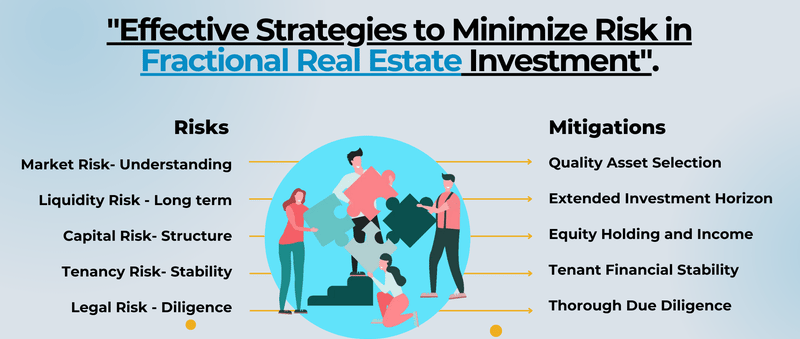
Own a Share in Premium Residential & Commercial Properties Starting from Just ₹15 Lakhs. Secure, Profitable, and Accessible Investments Await!
Navigating the Risks of Fractional Real Estate Investment: Strategies for Savvy Investors
Are you intrigued by the potential of fractional real estate but wary of the risks? Dive into our comprehensive guide that explores the key risks associated with fractional property investments and discover practical strategies to mitigate them. From liquidity challenges to market fluctuations and management pitfalls, we cover it all.
3 min read


Investing in fractional real estate involves owning a share of a property rather than the entire asset. While this type of investment can provide access to real estate markets with a smaller capital outlay, it also carries several risks.
Here are the primary risks and strategies to mitigate them:
Risks
Liquidity Risk:
Description: Fractional real estate investments can be less liquid than traditional real estate or publicly traded securities. It may be challenging to sell your share quickly if you need access to cash.
Mitigation:
Research the secondary market for fractional shares.
Consider the investment's time horizon and ensure you won't need immediate liquidity.
Choose platforms with a track record of providing liquidity options or secondary markets.
Market Risk:
Description: Real estate markets can fluctuate due to economic conditions, interest rates, and local market dynamics, affecting property values.
Mitigation:
Diversify investments across different geographical locations and property types.
Invest in properties with strong rental demand and stable income potential.
Stay informed about macroeconomic trends and local market conditions.
Management Risk:
Description: The performance of the property depends on the competency of the property management company. Poor management can lead to increased vacancies, higher expenses, and lower returns.
Mitigation:
Thoroughly vet the management company’s track record and reputation.
Ensure transparent communication and regular updates from the management team.
Review the management fee structure and performance incentives.
Operational Risk:
Description: Operational issues such as maintenance problems, tenant turnover, or legal disputes can impact the investment's profitability.
Mitigation:
Invest in properties with comprehensive maintenance plans and reserve funds.
Ensure the property management team has a proactive tenant retention strategy.
Consider properties with robust insurance policies to cover unexpected events.
Regulatory and Legal Risk:
Description: Changes in laws and regulations can impact property values, rental income, and operational costs. Additionally, fractional ownership structures can involve complex legal arrangements.
Mitigation:
Stay updated on local and national real estate laws and regulations.
Consult with legal professionals to understand the legal implications of fractional ownership agreements.
Choose platforms and properties with clear and transparent legal structures.
Valuation Risk:
Description: Valuing fractional ownership shares can be complex and may not always reflect the true market value of the underlying asset.
Mitigation:
Regularly review property appraisals and market comparables.
Understand the valuation methodology used by the platform or management company.
Seek independent valuations if necessary.
Technology and Platform Risk:
Description: As fractional real estate investments often rely on online platforms, there is a risk of technological failures, cybersecurity threats, or platform insolvency.
Mitigation:
Choose reputable platforms with strong security measures and a proven track record.
Diversify investments across multiple platforms to reduce exposure to any single platform's risk.
Regularly review platform security updates and policies.
Mitigation Strategies
Diversification: Spread investments across different properties, locations, and platforms to reduce exposure to any single risk.
Due Diligence: Conduct thorough research on the properties, management teams, and investment platforms before committing capital.
Regular Monitoring: Keep track of the performance and condition of your investments, and stay informed about market trends and regulatory changes.
Professional Advice: Consult with financial advisors, legal experts, and real estate professionals to ensure informed decision-making.
Insurance: Ensure properties have adequate insurance coverage to protect against potential losses from unforeseen events.
Clear Exit Strategy: Have a well-defined exit strategy, including understanding the process for selling your fractional shares and any associated costs or restrictions.
By understanding these risks and implementing effective mitigation strategies, investors can enhance their chances of achieving favourable outcomes in fractional real estate investments.
We're glad you enjoyed this post on Navigating the Risks of Fractional Real Estate Investment . In our newsletter, we delve deeper into these topics and provide actionable tips and strategies to help you achieve your goals in Alternative Asset class.
Stay ahead of the curve and subscribe to our newsletter for the latest insights and solutions!
Still Stuck? Ask Away
Write us at hello@realproft.com with any questions you have about real estate investing. We're here to help you find the perfect way to invest in your future!
Email us: hello@realproft.com
Social media
Subscribe to our newsletter to stay up-to-date with all the latest news and updates. By subscribing, you will receive regular emails containing valuable information, exclusive promotions, and exciting announcements. Don't miss out on this opportunity to join our community and be part of the conversation.
Call us: +91 7678255904
